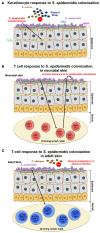Host Response to Staphylococcus epidermidis Colonization and Infections
- PMID: 28377905
- PMCID: PMC5359315
- DOI: 10.3389/fcimb.2017.00090
Host Response to Staphylococcus epidermidis Colonization and Infections
Abstract
The majority of research in the Staphylococcus field has been dedicated to the understanding of Staphylococcus aureus infections. In contrast, there is limited information on infections by coagulase-negative Staphylococci (CoNS) and how the host responds to them. S. epidermidis, a member of the coagulase-negative Staphylococci, is an important commensal organism of the human skin and mucous membranes; and there is emerging evidence of its benefit for human health in fighting off harmful microorganisms. However, S. epidermidis can cause opportunistic infections, which include particularly biofilm-associated infections on indwelling medical devices. These often can disseminate into the bloodstream; and in fact, S. epidermidis is the most frequent cause of nosocomial sepsis. The increasing use of medical implants and the dramatic shift in the patient demographic population in recent years have contributed significantly to the rise of S. epidermidis infections. Furthermore, treatment has been complicated by the emergence of antibiotic-resistant strains. Today, S. epidermidis is a major nosocomial pathogen posing significant medical and economic burdens. In this review, we present the current understanding of mechanisms of host defense against the prototypical CoNS species S. epidermidis as a commensal of the skin and mucous membranes, and during biofilm-associated infection and sepsis.
Keywords: Staphylococcus epidermidis; biofilm-associated infection; biofilms; coagulase-negative staphylococci; host defense; innate immunity; sepsis.
Figures


Similar articles
-
Staphylococcus epidermidis pathogenesis.Methods Mol Biol. 2014;1106:17-31. doi: 10.1007/978-1-62703-736-5_2. Methods Mol Biol. 2014. PMID: 24222452
-
Tracing Staphylococcus capitis and Staphylococcus epidermidis strains causing septicemia in extremely preterm infants to the skin, mouth, and gut microbiota.Appl Environ Microbiol. 2025 Jan 31;91(1):e0098024. doi: 10.1128/aem.00980-24. Epub 2024 Dec 18. Appl Environ Microbiol. 2025. PMID: 39692500 Free PMC article.
-
The role of Staphylococcus epidermidis in neonatal sepsis: guarding angel or pathogenic devil?Int J Med Microbiol. 2014 Jul;304(5-6):513-20. doi: 10.1016/j.ijmm.2014.04.013. Epub 2014 May 6. Int J Med Microbiol. 2014. PMID: 24881963 Review.
-
Antibacterial Effects of Phage Lysin LysGH15 on Planktonic Cells and Biofilms of Diverse Staphylococci.Appl Environ Microbiol. 2018 Jul 17;84(15):e00886-18. doi: 10.1128/AEM.00886-18. Print 2018 Aug 1. Appl Environ Microbiol. 2018. PMID: 29776929 Free PMC article.
-
The Staphylococcal Biofilm: Adhesins, Regulation, and Host Response.Microbiol Spectr. 2016 Apr;4(2):10.1128/microbiolspec.VMBF-0022-2015. doi: 10.1128/microbiolspec.VMBF-0022-2015. Microbiol Spectr. 2016. PMID: 27227309 Free PMC article. Review.
Cited by
-
Association between biofilm formation, structure and antibiotic resistance in Staphylococcus epidermidis isolated from neonatal septicemia in southwest Iran.Infect Drug Resist. 2019 Jun 27;12:1771-1782. doi: 10.2147/IDR.S204432. eCollection 2019. Infect Drug Resist. 2019. PMID: 31303772 Free PMC article.
-
Antibacterial Mechanism of Patrinia scabiosaefolia Against Methicillin Resistant Staphylococcus epidermidis.Infect Drug Resist. 2023 Mar 10;16:1345-1355. doi: 10.2147/IDR.S398227. eCollection 2023. Infect Drug Resist. 2023. PMID: 36925724 Free PMC article.
-
Advancements in antimicrobial nanoscale materials and self-assembling systems.Chem Soc Rev. 2022 Oct 17;51(20):8696-8755. doi: 10.1039/d1cs00915j. Chem Soc Rev. 2022. PMID: 36190355 Free PMC article. Review.
-
Caffeic Acid and Erythromycin: Antibacterial and Synergistic Effects on Staphylococci.Pharmaceuticals (Basel). 2025 Jun 26;18(7):964. doi: 10.3390/ph18070964. Pharmaceuticals (Basel). 2025. PMID: 40732254 Free PMC article.
-
Long-Term Monitoring of Bioaerosols in an Environment without UV and Desiccation Stress, an Example from the Cave Postojnska Jama, Slovenia.Microorganisms. 2023 Mar 22;11(3):809. doi: 10.3390/microorganisms11030809. Microorganisms. 2023. PMID: 36985383 Free PMC article.
References
-
- Bloom B., Schelonka R., Kueser T., Walker W., Jung E., Kaufman D., et al. . (2005). Multicenter study to assess safety and efficacy of INH-A21, a donor-selected human staphylococcal immunoglobulin, for prevention of nosocomial infections in very low birth weight infants. Pediatr. Infect. Dis. J. 24, 858–866. 10.1097/01.inf.0000180504.66437.1f - DOI - PubMed
Publication types
MeSH terms
Grants and funding
LinkOut - more resources
Full Text Sources
Other Literature Sources
Medical

